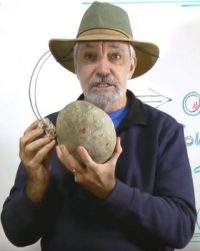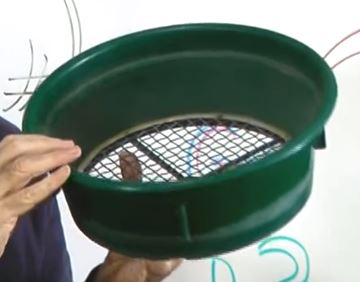Hey, it’s Prospector Jess here.
I’m gonna talk a little bit about Newton’s law of motion or F=ma, force equals mass times acceleration. Or another form of it is acceleration equals force over mass.
What’s that got to do with rocks?
Well rocks are masses. And acceleration, well that means that’s the gold flying out the back of your sluice box. I’m gonna talk about that in a second. To some of you this may look familiar.

The idea here, though, is very simple. You have a rock like that, and you have a rock like this. When the two of them come together, even though they’re made out of almost the same material, in terms of their specific gravity. When this big rock comes along and smacks this little guy, he is going to go bang!
And that bang basically imparts momentum into this, or acceleration. So this rock speeds up, the small one does. You’ve seen this with cue balls in a billiard game.
So the idea is, if we look at what we have, take a more moderate size pebble, this guy is more like that big huge boulder was. So when it smacks into this rock, it’s going to speed away down your sluice box. Poof.
That’s a bad thing. Out the back end it goes, and out goes your gold, if there’s gold in this. Or a smaller piece, even. Maybe a little tiny particle of gold that you have. When that particle of gold gets smacked, boom, out the back end. Bad thing.
So, how do you prevent that?
 I’m glad you asked. So what we have here, is a device. This device is called a classifier. A classifier is going to basically take these
I’m glad you asked. So what we have here, is a device. This device is called a classifier. A classifier is going to basically take these
rocks and sift them so that the bigger ones can’t go through the classifier. Even smaller ones, like our little shark’s tooth here, can’t go through this size classifier. This is a half inch.
I recommend a half inch in general because it’s a good size to go through things quickly. It doesn’t get plugged up, but it will sift everything half inch and lower out through the bottom and that can go into your pan or your sluice box.
Now, I like to have a half inch and a quarter inch with me at all times. The smaller gauge will sift out smaller particles of gold more readily, but they tend to get plugged up if you get too small for the kind of material you’re finding and it takes a lot longer to process.
Once you sift it, you put it into your pan, for example, and sift the material into the pan. You can do it dry or wet. One of the problems is if it’s moist and you have larger particles in a small gauge sluice, it becomes very hard, it can even plug up. So you have to have the right amount of material or you have to sift it wet, take your pick.
A large version of this, you’ll see on trommels and dredges, is called a grizzly. And all it’s doing is acting as a classifier sieve for particles that are smaller than the hole size that’s in it. The other material flows on downstream.
That material that goes downstream is going to be your lighter weight material. The stuff that’s gonna get dropped through contains your gold. That’s the objective here.
Now if you sift out stuff in your rock pile, such as your tailings from your dredge, you can quickly go over that, and here’s a tip, you can quickly go over that with a metal detector to find out if you’re missing stuff, embedded inside these rocks.
It doesn’t take but a couple seconds, sweep over. You flatten it out, you sweep over it and if it beeps, then you separate it out.
If it doesn’t, don’t worry. And generally, you’ll find out most of what you have is leverite. Leave ‘er right there.
Prospector Jess, over and out.
